Did you or your children get a nice shiny new bike for Christmas? Have a read of how Girl Guides in the 1920s were expected to look after their bikes and what they had to do to earn their Girl Guide Cycling Badge.
This article was written using extracts from the 1923 Girl Guide Magazine – a weekly publication that was every year collated into an “album” – enjoy
All-round, everyday efficiency is expected of the Cyclist Guide rather than ability to pass examinations tests. The owner of this badge is expected to be ready at a moment’s notice to use her machine for public service, and to do this she must keep both herself and her machine in perfect condition
- 1923 Girl Guide
CHOOSING A MACHINE
To gain the badge you MUST own a cycle. If you have not a machine of your own, and intend on purchasing one, get the very best machine you can afford. If you buy a new machine of a reliable make, you can always get a fair price for it later on if you need to sell it. Only buy a second-hand machine after you have had expert advice about it, or from a trustworthy friend. If you are just learning to ride, do your practicing, if possible, on a variety of old cycles, so that you will get an idea of the type of cycle which will suit you
The size of the gear is a matter that puzzles many beginners when choosing a machine. It should be remembered that although a low gear requires faster pedalling, it does not use up so much energy as a high gear and is better for hill-climbing. A simple rule which may be helpful is: a cyclist who is light in weight should have a lower gear than a powerfully built rider, and a heave machine should have a lower gear than a light machine.
RIDING YOUR CYCLE
To ride in comfort, using the least possible amount of energy, you must “fit” your machine. In other words, the saddle, handle-bars, and other details of your machine should be so arranged that they give a natural, upright position in your saddle form which you can get every ounce of power behind each stroke of the pedal. The height of the saddle should be adjusted so that when you are seated your heel will rest on the pedal when the latter is at its lowest point. The peak of the saddle should, as a rule, be directly over the centre of the crank-shaft, and the handle-bars should be in such a position that your arms drop easily on them, and allow an erect position, with elbows only slightly bent. Don’t have the saddle tilted forward, or your weight will fall on to your wrists. It is better to tilt saddle slightly backwards.
There is an art to pedalling. Too many cyclists do all their pedalling from the knee, with the ankle quite stiff, with the result that their leg muscles soon become tired. Pedalling should be done as much as possible from the ankle. You will soon get the correct action if you remember that when the pedal is at the top of its rise, your heel should be lower than the pedal, so that you can get plenty of power behind your forward thrust. As the pedal swing round, you help it backwards a little by raising the heel, afterwards dropping the heel as the pedal rises once more (see sketch below)
Just a warning or two. Don’t try long distance riding until you have trained for it, by gradually increasing the distance you ride at each trip. Don’t ride on an empty stomach, or too soon after a meal. Don’t rush hills, take them steadily, and, if necessary, walk up. Many beginners will ride up all the hills during the first part of the journey and expend so much of their energy that they can only crawl up the later ones.
Keep your tyres well inflated, as a hard tyre will resist thorns, small stones etc., better than a flabby one. The soft tyre also presents more of its surface to the road, so that the wear and tear on it is greater than on a hard tyre. The front tyre of your machine need not, however, be blown up so tightly as the back one.
REPAIRS
The most common repair which the cyclist has to deal with is, of course, the puncture. To meet this emergency, it is advisable to keep a well-stocked repair outfit in your saddle-bag. By the way, always remember to take out your puncture repair outfit before placing your machine upside down when you have a puncture to mend. The process of mending a puncture should never be hurried. Always clean the surface of the tube around the puncture well and allow the solution to dry “tacky” before applying it, or, in most cases, you will find that the patch will very soon be forced out of position. Again, always dust the patch after it is in place, to prevent the tube from sticking to the outer cover. French chalk (or even dust form the road that is free from grit) may be used for this. A penny placed on either side of the tube and held in position between the thumb and the fingers, will give you a good pressure upon the patch. A simple way to find the puncture without water is to inflate the tyre and the pass it close you your cheek. The tiny stream of air will readily make itself felt. Immediately upon finding a puncture mark it in some way to avoid the annoyance of having to search for it again.
- A group of guides with their cycles
OVERHAULING
A cycle should be overhauled about every six months. Any large repairs may be done by the local cycle engineer, but smaller ones may be tackled by the Guide herself. A little oil frequently is better than a lot at irregular intervals. Bearings should be given regular attention. A simple way to treat them is to flood them with paraffin until they run smoothly and then lubricate them in the usual way. Pedal bearings are often neglected, but if you attend to them at intervals, giving them a good cleaning and oiling, you will be repaid by extra smoothness of running.
Though often the most neglected, the chain is, perhaps, the most important part of the machine. Unless the chain is well cared for, the machine will never run sweetly. A good rule to remember with regard to the chain is that it should be kept moist and clean on the inner side and clean and dry on the outer side. To effect this, oil the inner side of the links frequently with lubricating oil, and occasionally give the outer side a rub with the black-lead brush borrowed from the housemaids box. Graphite (another name for black-lead or graphic polish) is an excellent dry lubricant.
For general cleaning, remove caked mud with a damp cloth and rub down nickel parts with an oily woollen cloth, especially after rain. In winter, it is a good plan to give all the nickel parts a thin coating of Vaseline, to protect the plating. The hubs of the wheels are always awkward to clean and a simple idea to keep the bright is to make a loop of string or tape around each hub. The loop should be free to revolve as the wheel turns and the continuous friction keeps the hub clean. Useful hints on keeping your bike in good trim can be obtained from the booklets which are issued by the makers of the machine. The booklet will, as a rule, explain the positions and uses of the various parts.
MOUNTING YOUR MACHINE
To be able to do this from either side is a useful accomplishment, which can be acquired by practice, and which is useful in crowded thoroughfares when one has to dismount in an emergency. To be able to lead another cycle whilst riding your own is often useful when you are lending spare cycle to friend or when another cycle is disabled slightly but still can be wheeled.
- 1920s Cyclist’s Badge
- Slightly later version
In order to pass the cyclist’s badge the Girl Guide had to be able to read a map and relay a message and here are some hints given in the magazine – not a sat-nav or iphone in sight of course!!
To read maps well, the Guide must commit to memory the various signs used in Ordnance survey maps. If possible, get a good Ordnance map of your district and use it on every possible occasion. It is interesting and useful to plan out your tramps or cycling tours beforehand on the map. In this way, by noting the contours, you can, if necessary, avoid any steep hills, or take short cuts, which you might miss without a map.
Repeating a verbal message often proves a stumbling block to would be badge winners. The great secret is to pay special attention to the message that is given to you. Whenever you forget a thing, you will generally find it is because you did not really grasp the message or command in the first place. If you are told to meet Mrs Brown at White House at seven o’clock, for instance, picture in your mind Mrs Brown, the White House and a clock with the hands at seven o’clock. In this way you will give yourself three chances of remembering your appointment, because if you remember any one of the three facts, the other two are almost certain to spring to mind immediately. Remember then that attention is the secret of remembering messages. You may also find it helpful to repeat the message once or twice immediately upon hearing it.
Now – hands up how many of you look after your bike this well ….
Article © Margaret Roberts

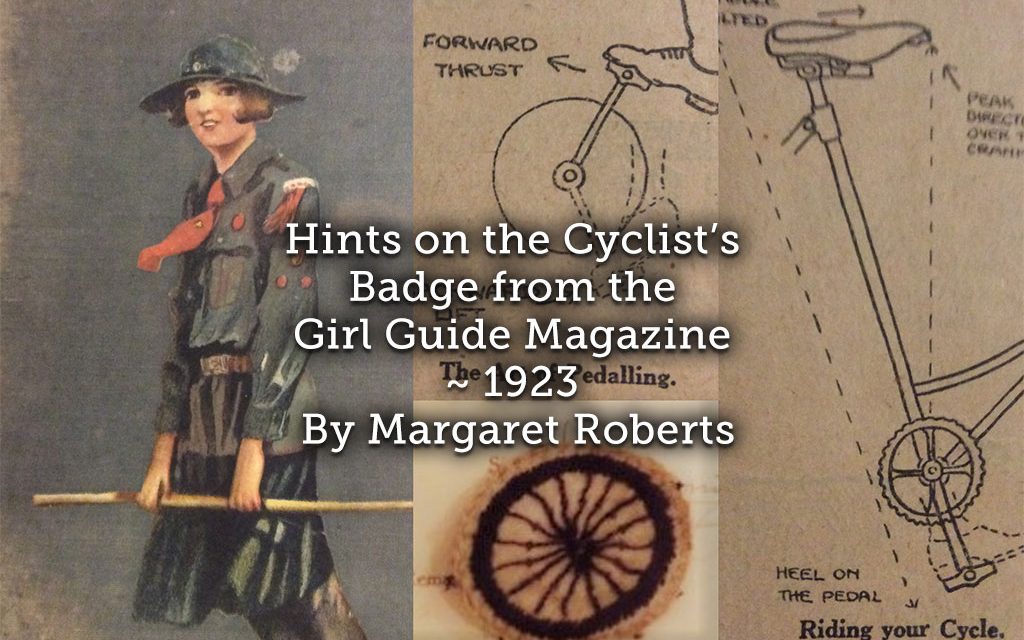
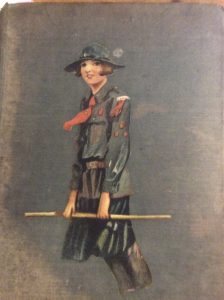
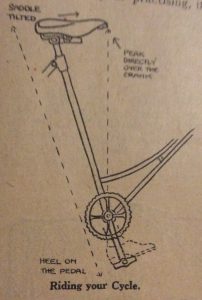
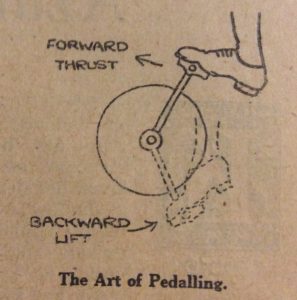
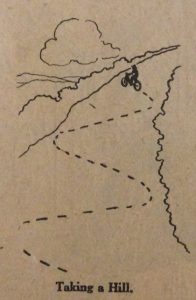
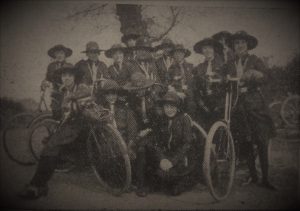
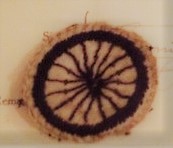
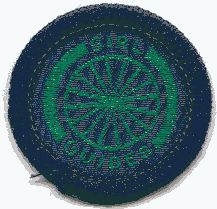
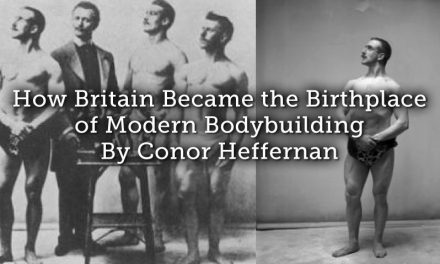
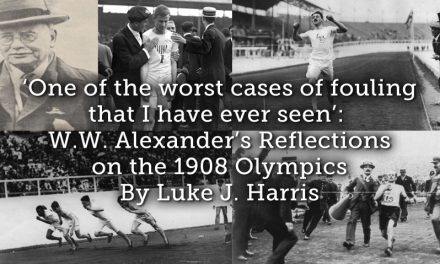
![The Eternal Seconds of Italian Women’s Athletics:<br>The History of Gruppo Sportivo La Filotecnica [Milan, 1935-1943]](https://www.playingpasts.co.uk/wp-content/uploads/2020/07/PP-banner-maker-3-440x264.jpg)
